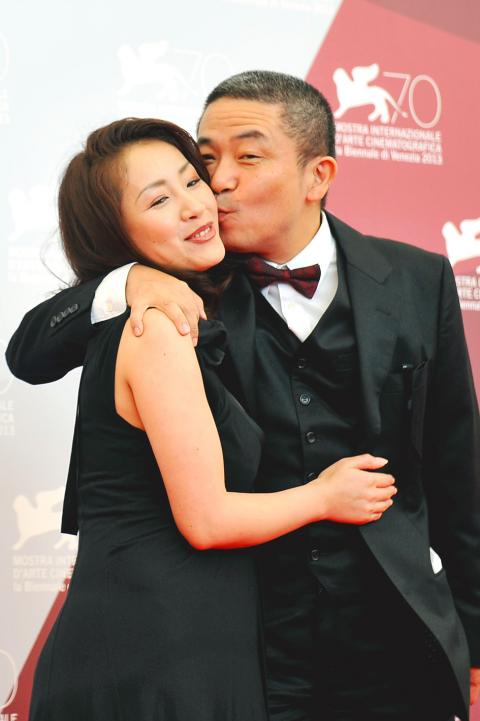Japanese director Sion Sono wants to set the records straight: It was Bruce Lee and not Quentin Tarantino who transformed the yellow jumpsuit into a piece of film iconography.
Sono has been fielding questions all day about Tarantino’s influence on his film Why Don’t You Play in Hell?, which premiered to an enthusiastic reception out of the main competition at the Venice Film Festival last Thursday.
The raucous gangster drama telling the story of a young filmmaker aiming at cinematic greatness is full of over-the-top graphic violence, and a would-be action star wears a yellow jumpsuit, as sported by Uma Thurman in Tarantino’s Kill Bill.

Photo: AFP
“I speak as head of the ‘Bruce Lee Fan Club,’’’ Sono said in an interview.
“Everyone is talking about the yellow tracksuit as something from Tarantino, but that is very sad for me. The original idea was Bruce Lee’s, and now everyone thinks it came from Tarantino.”
Sono drafted Jun Kunimura, a veteran of John Woo films who also appeared as Boss Tanaka in both Kill Bill movies, to star as a clan boss whose wife single-handedly massacres a rival gang. The movie also stars Fumi Nikaido, recipient of Venice’s young actress award in 2011 for her role in Sono’s film Himizu, as the clan boss’s daughter who longs for stardom after her career as a toothpaste TV commercial star is quashed by her mother’s murderous tirade.
Kunimura said he enjoyed the chance to play a character that didn’t have to be controlled.
“For my whole career, my expression has been the opposite of exaggerated. I would try to be as straight as possible,” Kunimura said, adding that Sono “is crazy, in a good way.”
Against the backdrop of spiraling gang violence, a young filmmaker inspired by Sono himself and played by Hiroki Hasegawa assembles a film troupe determined to make one great film.
The gang/filmmaker plot lines weave together and climax with gangsters and filmmakers both shooting guns and cameras, respectively, in one small space.
Sono wrote the script 20 years ago — before the Kill Bill movies, he points out — as a portrait of his own struggles to become a filmmaker. “I wanted to create something purely interesting,” he said.
“The film is about the problems I faced” as an aspiring filmmaker, Sono said, and he included episodes from his own life, including a scene when a bunch of kids makes fun of, then tries to beat up a Bruce Lee-style actor as the troupe films in a park.
The movie brims with good-natured absurdity and pokes fun at the movie industry, ruefully commenting on the decline of modern cinema.
The young filmmaker, full of ambition, bemoans the decline of 35mm even as he shoots on video, and wears a Cannes T-shirt with an Oscar statuette.
“Perhaps it was a miscalculation, because I didn’t think this movie would come to either Cannes or Venice,” Sono said.

May 18 to May 24 Pastor Yang Hsu’s (楊煦) congregation was shocked upon seeing the land he chose to build his orphanage. It was surrounded by mountains on three sides, and the only way to access it was to cross a river by foot. The soil was poor due to runoff, and large rocks strewn across the plot prevented much from growing. In addition, there was no running water or electricity. But it was all Yang could afford. He and his Indigenous Atayal wife Lin Feng-ying (林鳳英) had already been caring for 24 orphans in their home, and they were in

On May 2, Chinese Nationalist Party (KMT) Chairman Eric Chu (朱立倫), at a meeting in support of Taipei city councilors at party headquarters, compared President William Lai (賴清德) to Hitler. Chu claimed that unlike any other democracy worldwide in history, no other leader was rooting out opposing parties like Lai and the Democratic Progressive Party (DPP). That his statements are wildly inaccurate was not the point. It was a rallying cry, not a history lesson. This was intentional to provoke the international diplomatic community into a response, which was promptly provided. Both the German and Israeli offices issued statements on Facebook

President William Lai (賴清德) yesterday delivered an address marking the first anniversary of his presidency. In the speech, Lai affirmed Taiwan’s global role in technology, trade and security. He announced economic and national security initiatives, and emphasized democratic values and cross-party cooperation. The following is the full text of his speech: Yesterday, outside of Beida Elementary School in New Taipei City’s Sanxia District (三峽), there was a major traffic accident that, sadly, claimed several lives and resulted in multiple injuries. The Executive Yuan immediately formed a task force, and last night I personally visited the victims in hospital. Central government agencies and the

Australia’s ABC last week published a piece on the recall campaign. The article emphasized the divisions in Taiwanese society and blamed the recall for worsening them. It quotes a supporter of the Taiwan People’s Party (TPP) as saying “I’m 43 years old, born and raised here, and I’ve never seen the country this divided in my entire life.” Apparently, as an adult, she slept through the post-election violence in 2000 and 2004 by the Chinese Nationalist Party (KMT), the veiled coup threats by the military when Chen Shui-bian (陳水扁) became president, the 2006 Red Shirt protests against him ginned up by